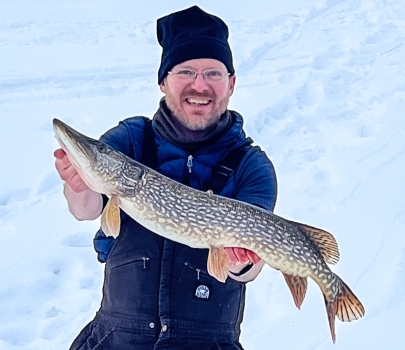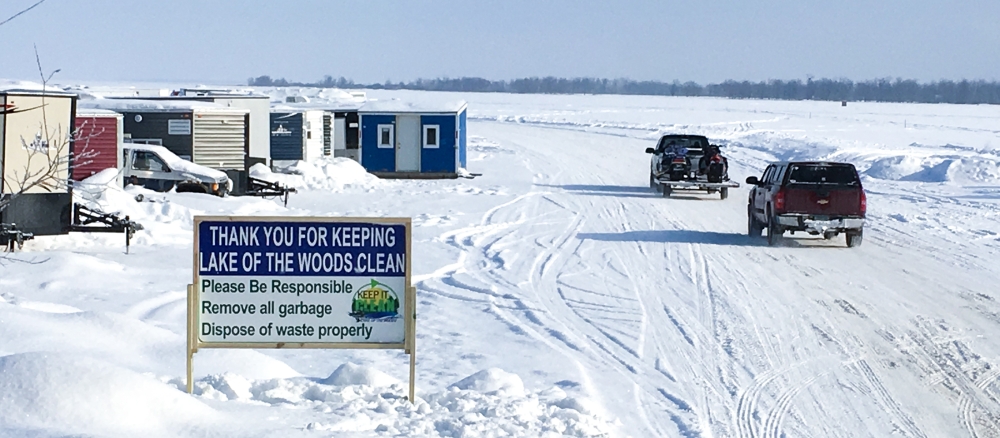
Mike Hirst lives in northwest Minnesota, near the border between the U.S. and Canada. Like many locals, Mike likes to fish on Lake of the Woods, which offers some of the best year-round fishing in Minnesota.
While the fishing remains high quality for now, Hirst and others have noticed an increase in problematic garbage and human waste in the lake after the ice fishing season ends.
Hirst says there are a couple of reasons for the problem. First, a lot more people make their way out on the ice nowadays. Since the 1980s, winter angling hours on Lake of the Woods have increased five to six times. On a busy weekend, there can be 10,000 people fishing on the ice — in a county with a population of 4,000. In addition, the amount of time spent on the ice has changed.
“Back in the Eighties, people would go on the ice, they would fish, and they would come off the ice,” Hirst says. “Now, with the advent of wheeled fish houses, it's become like a campground on the ice.”
The tourism is great, Hirst says, but the unintended consequences, like trash and pollution in the lake, are not. In his role as a resource technician for the Lake of the Woods Soil and Water Conservation District, Hirst decided to do something about the problem. In 2012, he brought together a group that included representatives from Lake of the Woods Tourism, local governments, and the Minnesota Department of Natural Resources. They started a campaign, Keep It Clean, focused on the growing problem of garbage and human waste left on the ice by anglers and other visitors during ice fishing season. Keep it Clean is addressing the problem through education, infrastructure improvements, and policy. Since then, Keep it Clean efforts have spread to Upper and Lower Red Lakes, Mille Lacs Lake, other states, and even Canada.
Mike says that at the end of the day “what we're trying to do is change social behaviors, which is difficult. It takes time and effort. This isn't something that we're looking to do forever. We hope that at some point, this is something that is just accepted.”
The immense support for the campaign has Mike hopeful for the future. “I see this as just the start of Keep It Clean,” he says. “I think it will continue to grow and make a difference for water quality in Minnesota and beyond.”
For more information about Keep it Clean and what to do on your next ice fishing adventure, visit www.keepitcleanmn.org.
Learn more in the We Are Water MN exhibit
Hirst shared his story as a part of We Are Water MN, a traveling exhibit and community engagement program that explores Minnesotans’ relationships with water. The exhibit will make its next stop at the Roseau County Historical Society and Museum this fall.
At the exhibit you will find:
- Stories from people in this watershed about the role water plays in their work and recreation.
- Interactive exhibits about what makes the Roseau River watershed unique and the challenges around keeping water healthy.
- Events to help you discover many ways to engage in water protection.
Visit the exhibit August 17 through October 9 at the Roseau County Historical Society and Museum, 121 Center Street East, Roseau, MN 56751. Exhibit hours are 9:30 a.m. to 5 p.m., Monday through Friday. Admission is free.
Events and activities
The Historical Society has several events planned in conjunction with the exhibit, including:
- Opening reception, from 5-7 p.m. on August 17, with remarks at 5:30 p.m.
- Plein-air watercolor painting along the Roseau River, from 2-5 p.m. September 7, and from 5-8 p.m. September 8. This class will be taught by Debbie Aune, Northwest Minnesota Artist of the Year.
About We Are Water MN
We are Water MN is led by the Minnesota Humanities Center in partnership with the Minnesota Pollution Control Agency; the Minnesota Historical Society; the Board of Water and Soil Resources; the Minnesota Departments of Agriculture, Health, and Natural Resources; and University of Minnesota Extension.
The program is funded, in part, with money from the Clean Water, Land & Legacy Fund — which was created by Minnesota voters on Nov. 4, 2008 — and by the National Endowment for the Humanities.
